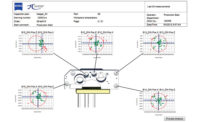COLUMBIA, MD-The latest data is starting to turn in a decidedly positive direction; GDP numbers are the best in over a year and a half, suggesting that the recession is in clear retreat. After a mild recovery in the third quarter, numbers jumped 5.8% in the fourth. The bulk of this growth is attributed to manufacturers starting to replenish inventories, mostly since the beginning of December.
This shift in strategy is reflected in the Credit Managers’ Index (CMI) numbers as well. “The jump in manufacturing was stark and unexpected and, since the decline registered in the last iteration of the index, there has been a major leap in some critical areas,” says Chris Kuehl, Ph.D., economist for the National Association of Credit Management (NACM). “The combined CMI saw a jump from 52.9 to 55.1, which is impressive enough, but the real movement came from the manufacturing side,” he says. Reinforcing the message coming from the economy as a whole, the manufacturing sector jumped from 52.1 to 55.1, reversing the trend from the December index when the sector stagnated and slipped in terms of positive factors.
There was an improved atmosphere in both manufacturing and service sectors resulting with the most activity in the combined index’s favorable factors, specifically sales and new credit applications. Sales in the combined index jumped from 56.7 to 60.7, marking the first time this figure has been above 60 in 18 months. There was also progress in new credit applications-a jump from 54.2 to 57-signaling movement in the credit sector despite ongoing issues in the financial community. One of the biggest leaps came from dollar collections, which sported readings in the 40s just nine months ago and is now at 61.3. The same pattern can be seen in amount of credit extended, now standing at 58.8 after sitting in the 40s just five months ago.
“The past pattern in the index suggests that this is developing into a classic recession exit,” says Kuehl. “The deterioration of inventory and the dramatic reduction in capacity utilization meant that any spark of demand would propel business out of this predicament and, as in past recessions, the months following the end of these strategies would show substantial growth. The trillion-dollar question is whether this growth surge can be maintained throughout the rest of the year.”
Thus far, these are the highest numbers seen in the index since February 2009 when the initial impetus of the recession was broken. Since then, growth has been even, but not dramatic. That trend of slow growth is likely to return, but the suggestion from this month’s data is that there will be pretty substantial gains for the bulk of the first quarter.
A pattern appears each time there is a recession and, in this downturn, that pattern has been as visible as it was during the recessions of the early 1970s and 1980s. The strategy employed by most companies in the face of financial strain is to reduce costs to the barest of minimums, which involves slashing the workforce, postponing or eliminating capital expenditures and reducing inventory to the lowest possible level. The CMI’s figures on capacity utilization reflect this strategy as they have fallen to levels not seen since the depths of the 1980s double-dip recession. The strategy for retailers was as extreme as it has ever been-betting that the consumer would grab whatever they could find during the holiday season-and the effort seemed to work, as the retailers managed to pull off a decent December in spite of the limited offerings. On the manufacturing side, this inventory reduction was extreme and extended such that by the end of the year supply was dangerously low, especially if one wanted to hang onto market share when recovery arrived.
“For two months, the CMI told a story. The number of disputes fell, dollars out for collection declined and so did almost all the factors that indicated debt was going unpaid,” says Kuehl. He further commented that the process of catching up on that debt was the first step toward returning inventory levels, and companies that needed to buy raw materials for production had to get current with their creditors, a process that began in earnest in November and in some cases as early as October. By December, the purchasing had officially started. The evidence of this recovery was noticeable in other sectors as well. The first transportation sector that would see gains when factories started back up was rail and, sure enough, freight volumes started to climb in the rail sector in November and have been climbing steadily ever since.
It is far too early to assert that manufacturing has finally escaped the ravages of this recession, but the first stage is underway. The boost provided by the need to replenish inventory has already helped to stabilize some of the metals prices and has resulted in renewed activity in everything from transportation to warehousing. The next step in the recovery will be for consumer demand to draw down this newly-established inventory and necessitate its replacement. This has yet to develop, but there are some hopeful signs. For the moment, the good news lies in the future, reflected in the manufacturing index by jumps in sales as well as amount of credit extended.
There was less dramatic movement in the service sector, but progress was registered nonetheless. The increase in sales was notable, although not as significant as in manufacturing this month. What is good to see is the index has crested above 60 in both new credit applications and dollar collections. Kuehl noted that it was only four or five months ago that both of these factors had readings in the 40s and, a year ago, new credit applications was in the 30s. The credit squeeze has certainly not ended, but there is more available now than there has been for almost 18 months. The system has not returned to the profligate ways of the last decade, but that is likely a good thing. The old-school thinking that used to dominate the banks and financial institutions seems to have made a bit of a comeback, which is now freeing up credit for those that are traditionally creditworthy.
The contrast between January 2009 and January 2010 is stark and the distance between the two is likely as broad as it will be for some time. It was a year ago that the recession reached its deepest point and the index showed numbers buried in the 40s. Now the index has climbed into solid expansion territory and is well into the mid 50s. It is not likely that this trajectory will be maintained indefinitely as there are still questions about how fast consumers will start to draw down new inventory, but there is also not much that would suggest a major decline at this point. The National Association of Credit Management (NACM) supports approximately 19,000 business credit and financial professionals worldwide with premier industry services, tools and information. NACM and its network of Affiliated Associations are the leading resource for credit and financial management information and education, delivering products and services, which improve the management of business credit and accounts receivable. This report, complete with tables and graphs, and the CMI archives may be viewedhere.
Get our new eMagazine delivered to your inbox every month.
Stay in the know with Quality’s comprehensive coverage of the manufacturing and metrology industries.
SIGN UP TODAY!Copyright ©2024. All Rights Reserved BNP Media.
Design, CMS, Hosting & Web Development :: ePublishing


